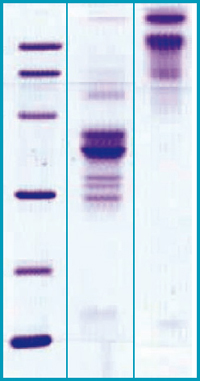Type
Recombinant protein
Description
Total 289 AA. Mw: 31.9 kDa (calculated). C-Terminal Flag-tag, 12 AA. The AA sequence is identical to Swiss-Prot- O76061 (STC2, aa 25–302).
Amino Acid Sequence
TDATNPPEGPQDRSSQQKGRLSLQNTAEIQHCLVNAGDVGCGVFECFENNSCEIRGLHGICMTFLHNAGKFDAQGKSFIKDALKCKAHALRHRFGCISRKCPAIREMVSQLQRECYLKHDLCAAAQENTRVIVEMIHFKDLLLHEPYVDLVNLLLTCGEEVKEAITHSVQVQCEQNWGSLCSILSFCTSAIQKPPTAPPERQPQVDRTKLSRAHHGEAGHHLPEPSSRETGRGAKGERGSKSHPNAHARGRVGGLGAQGPSGSSEWEDEQSEYSDIRRAAADYKDDDDK
Thr 1 to Asn 5 were confirmed by N-terminal sequencing
Source
HEK293
Purity
˃ 90 % by SDS-PAGE
SDS-PAGE Gel
12% SDS-PAGE separation of Human STC-2
1. M.W. marker – 14, 21, 31, 45, 66, 97 kDa
2. reduced and heated sample, 5μg/lane
3. non-reduced and non-heated sample, 5μg/lane
Endotoxin
< 1.0 EU/µg
Formulation
Filtered (0.4 μm) and lyophilized in 0.5 mg/mL in PBS buffer, pH 7.4
Reconstitution
Add deionized water to prepare a working stock solution of approximately 0.5 mg/mL and let the lyophilized pellet dissolve completely.
Applications
Western blotting, ELISA
Shipping
At ambient temperature. Upon receipt, store the product at the temperature recommended below.
Storage/Expiration
Store the lyophilized protein at -80 °C. Lyophilized protein remains stable until the expiry date when stored at -80 °C. Aliquot reconstituted protein to avoid repeated freezing/thawing cycles and store at -80 °C for long term storage. Reconstituted protein can be stored at 4 °C for a week.
Quality Control Test
BCA to determine quantity of the protein.
SDS PAGE to determine purity of the protein.
Endotoxin level determination.
Note
This product is intended for research use only.
Research topic
Bone and cartilage metabolism, Oncology
Summary
Stanniocalcin 2 (STC2) is a secreted, homodimeric glycoprotein that is expressed in a wide variety of tissues including muscle, heart, pancreas, kidney, spleen, prostate, small intestine, colon and peripheral blood leukocytes. The encoded protein has 10 of its 15 cysteine residues conserved among stanniocalcin family members and is phosphorylated by casein kinase 2 exclusively on its serine residues. Its C-terminus contains a cluster of histidine residues which may interact with metal ions. STC2 may have autocrine or paracrine functions. The protein may play a role in the regulation of renal and intestinal calcium and phosphate transport, cell metabolism, or cellular calcium/phosphate homeostasis. Constitutive overexpression of human stanniocalcin 2 in mice resulted in pre- and postnatal growth restriction, reduced bone and skeletal muscle growth, and organomegaly. STC2 is also known to be involved in the regulation of unfolded protein response in the endoplasmic reticulum (ER), as well as in the regulation of cell proliferation under hypoxic conditions. In addition, a series of recent studies have shown that STC2 is also associated with cancer development. The expression of STC2 is up-regulated in several cancer types, including gastric cancer, neuroblastoma, colon cancer, prostate cancer and breast cancer. Expression of STC2 gene is induced by estrogen and altered in some breast cancers. It was found the significant difference in the activity of the MAPK signaling pathway between cisplatin sensitive and resistant cervical cancer cells, and that STC2 could regulate the activity of the MAPK signaling pathway. This suggesting an important role for STC2 in the development and progression of cancers but despite these pioneering studies, the clinical significance and molecular mechanism of STC2 in cancers, however, still remain controversial and need to be further elucidated.
Product Datasheet (RUO)
Datasheet PDF (RUO)
Datasheet PDF (RUO)
Safety Information (RUO)
MSDS (RUO)
Find documents for the lot

